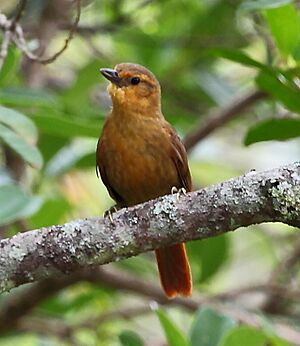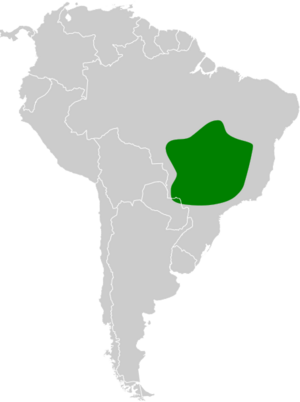Planalto foliage-gleaner facts for kids
Quick facts for kids Planalto foliage-gleaner |
|
|---|---|
 |
|
| at Serra da Canastra National Park, Minas Gerais state, Brazil | |
| Conservation status | |
| Scientific classification | |
| Genus: |
Syndactyla
|
| Species: |
dimidiata
|
 |
|
| Synonyms | |
|
|
The planalto foliage-gleaner (Syndactyla dimidiata) is a type of bird. It is also known as the russet-mantled foliage-gleaner. This bird belongs to the ovenbird family called Furnariidae. You can find it living in Brazil and Paraguay.
Contents
About Its Name and Family
Scientists group birds into families. The planalto foliage-gleaner was once placed in a group called Philydor. But new studies looked at its body and its sounds. They also used special DNA information. This showed it actually belongs in the Syndactyla group. It's like finding out a cousin is actually a sibling!
Most bird experts agree this bird is one single type. But some groups think there might be two slightly different kinds. One is called S. d. dimidiata. The other is called S. d. baeri. However, a recent study suggests baeri might not be a separate type after all. This article treats the planalto foliage-gleaner as one main type.
What It Looks Like
The planalto foliage-gleaner is about 17 centimeters (6.7 inches) long. It weighs between 27 and 32 grams (about 1 ounce). This is a medium-sized bird with a long, pointed beak. Both male and female birds look the same.
Adult birds have a mostly reddish-orange face. This color is brighter above their eyes, like eyebrows. Their ear feathers are a bit darker. Their head and upper body are bright reddish-brown. Their tail is a reddish-chestnut color. Their wings are dark reddish-brown with brighter edges.
Their throat and belly are mostly plain reddish-orange. They have faint pale stripes on their chest. Their sides have a slight olive color. Their eyes are brown. Their upper beak is dark brown, and their lower beak is horn-colored with a pinkish base. Their legs and feet are olive green. Young birds have a shorter beak. They also have a whitish throat and brown bars on their chest.
Where It Lives and Its Home
The planalto foliage-gleaner lives in the southern planalto region. This area stretches from Brazil's Mato Grosso state east to Bahia. It goes south to Paraná and into eastern Paraguay. In Paraguay, it is found in Concepción and Amambay areas.
This bird likes to live in lowland tropical evergreen forests. It also lives in gallery forests, which are forests along rivers. You can also find it in tropical woodlands within the cerrado region. It lives at elevations from 100 to 1,200 meters (330 to 3,900 feet) high.
Its Behavior
Movement
The planalto foliage-gleaner stays in the same area all year round. It does not migrate.
Feeding
Scientists don't know much about what the planalto foliage-gleaner eats. But they think it mainly eats arthropods, like insects and spiders. These birds are usually seen looking for food in pairs. Sometimes, they join groups of different bird species feeding together. They search for food from the lower parts of the forest up to the middle layers. They find their prey on branches and on plants growing on other plants, called epiphytes.
Reproduction and Life Cycle
We don't know anything about how the planalto foliage-gleaner breeds.
Vocalization
The song of the planalto foliage-gleaner sounds like "a small, slowly starting motorbike". It is a short or very long series of "tsjek" notes. The notes go higher in pitch. They start and end with some stuttering sounds. Its call to other birds is a loud, nasal "cheh". It can be a single sound or repeated twice.
Its Status
The IUCN (a group that checks how safe species are) first listed the planalto foliage-gleaner as "Near Threatened". But since 2004, it has been listed as "Least Concern". This means it is not currently at high risk of disappearing.
Even though it has a large area where it lives, we don't know how many of these birds there are. Scientists believe their numbers are going down. The bird is likely threatened by farms taking over forest areas in Brazil. More information is needed about how many birds there are and if their numbers are changing. It seems to be rare in its habitat. It also doesn't do well in forests that have been disturbed a lot by humans. However, it does live in a few protected areas.


